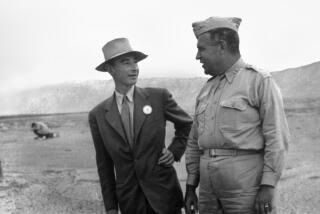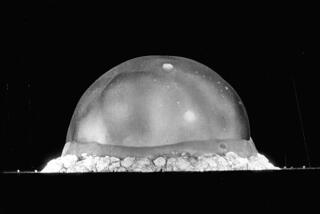Dissenter on ‘Star Wars’ Leaves Livermore Lab
A nuclear weapons scientist who publicly questioned the feasibility of a key part of the Star Wars program is leaving Lawrence Livermore National Laboratory, where he once did battle with one of the legendary names in nuclear physics, Edward Teller.
Roy Woodruff, 49, former director of Livermore’s nuclear weapons program, announced Wednesday that he is moving to the Los Alamos National Laboratory in New Mexico, where he will become a senior adviser in the arms control and verification program.
Woodruff stepped down as leader of Livermore’s weapons program in 1985 after a bitter dispute with Teller--”father of the H-bomb”--and Teller’s protege, Lowell Wood. He accused the two scientists of being “overly optimistic” and misleading then-President Reagan about the feasibility of using space-borne lasers to zap enemy missiles.
After the dispute became public, Woodruff, a highly respected researcher who has spent 21 years at the laboratory, found himself left with little to do.
On Wednesday, Woodruff acknowledged in a telephone interview that “of course (the dispute) had something to do” with his decision to switch to Livermore’s rival institution at Los Alamos. Both laboratories are are managed by the University of California for the U.S. Department of Energy .
“But I’m very happy with the decision,” he said. “I respect the people at this lab but I think it’s time to move on. I’m delighted with this opportunity. We’re putting the controversy behind us.”
The move came as no surprise. Woodruff put his home up for sale in the San Francisco Bay Area community of Livermore a couple of years ago, explaining that he feared his position there might become “untenable.”
His fight with Teller, who now is an associate director emeritus at Livermore, grew out of a disagreement over the “Super Excalibur” project, an orbiting X-ray laser that--theoretically--would concentrate beams of light from a nuclear explosion so intensely that they would destroy missiles.
Teller, a Reagan confidant, pushed the program in Washington, arguing that Excalibur could be a crucial part of a nuclear shield that would protect this nation from an intercontinental attack by the Soviet Union. Reagan bought the concept and the Strategic Defense Initiative, popularly known as “Star Wars,” was born.
But Woodruff thought Teller and others at Livermore had vastly oversold the program, and he said later he was denied the opportunity to make his views known to the President. The debate finally reached the public arena and Woodruff found himself criticized by everyone from the secretary of energy on down.
He said he was given a routine job with little to do, and finally he filed a complaint with the University of California, charging that he was being punished for criticizing the laser program and Teller. The university upheld the complaint and ordered to lab to give him a better job.
He became head of the lab’s effort to develop techniques for verifying compliance with nuclear arms treaties. He said Wednesday he will continue that work in his new home in New Mexico.





